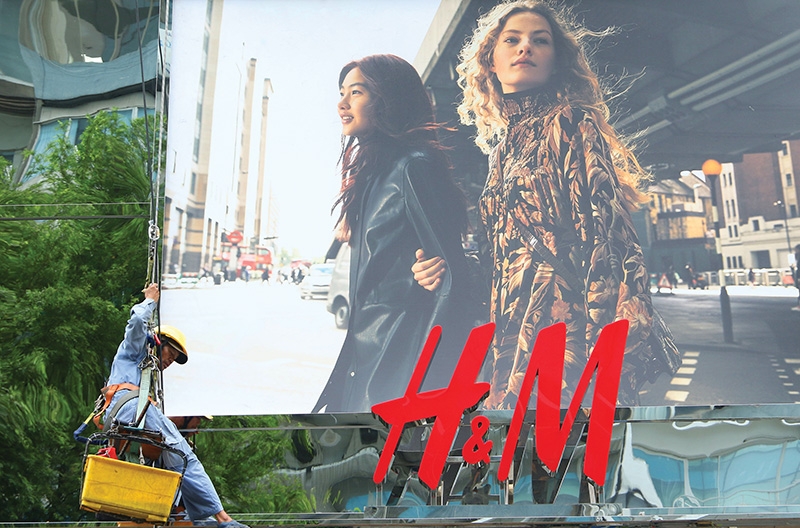H&M fighting to save fanbase after social media backlash
 |
| Fashion retailers like H&M have suffered from negative comments, photo Le Toan |
As a consequence of integrating the “nine-dash line” map into online shopping websites in the Chinese market, a great number of local young people have called for a boycott on the Swedish fashion brand, causing a week-long desert atmosphere to drift over most of its outlets in Vietnam.
Xuan Huong, a 22-year-old student based in Hanoi, said that as soon as the case flared up, she became no longer interested in shopping with H&M.
“I was very disappointed,” Huong stressed. “I used to be a fan of the brand because of the reasonable prices and eye-catching designs of most items. But from now, I may never purchase anything from H&M due to its disrespect to Vietnamese consumers who they have earned from for more than three years.”
Dung Thang, a 25-year-old officer in the capital’s Ba Dinh district said, “Before this incident I had no intentions to buy any items from H&M because their quality is not good while also being overpriced. Now, this case has only cemented my decision.”
Over a period of three days last week across Hanoi’s stores in Vincom Nguyen Chi Thanh and Vincom Mega Mall Royal City, there was a visible drop in the number of shoppers venturing into the store while visiting the malls. It was reported that customer numbers in other H&M outlets in Vincom Times City, AEON Hadong, and Vincom Mega Mall Ocean Park were slightly better, but not a patch on before the pandemic.
A staff member in Vincom Times City even revealed that the number of customers is fewer than in 2020 at times when people were more inclined to avoid going out unless necessary. “The store last year was even more crowded than now,” the staff member said.
Facing near emptiness for over a week, H&M Vietnam’s daily sales are at a large risk of seriously plunging, potentially interrupting its revenue targets in Vietnam for 2021. H&M’s financial report two years ago highlighted that the fashion brand earned on average VND3 billion ($130,000) per day based on revenues of VND1.12 trillion ($48.7 million) for eight stores at the time.
“We have yet to offer any statements for now,” said Pham Ngoc, head of Communications and PR at H&M Vietnam when asked about the potential trouble ahead.
Indeed, the fashion brand has experienced a tough time in Vietnam since early last year when the pandemic broke out. Its entire batch of establishments there had to close during social distancing, deepening the pressures on leasing and staff costs.
Over the second quarter of last year when the health crisis reached a peak, H&M’s net sales in the Vietnamese market was $7.77 million, down 32 per cent on-year, according to company reports covering the first six months of 2020.
Its revenue in other markets also dropped significantly during the timeline. In China, the clothes maker’s net earnings decreased by 28 per cent to $262 million. Nevertheless, the report noted, the country of 1.4 billion people remains its third-largest market, following Germany and the United States.
China takes on an even greater importance as H&M’s performance in Germany and the US are growing wearier, as reflected by revenues dropping by 42 per cent and 71 per cent, respectively.
In 2018, according to Bloomberg, the company declared high amounts of stockpiles worth $4 billion, equivalent to 17.6 per cent of its turnover of the year’s first quarter, while profit was at a 16-year low. As of February of that year, H&M’s net profit reduced to 44 per cent on-year, equivalent to $167.4 million.
Under pandemic-induced lockdowns, the brand has shut 250 stores across the globe since October – after already closing 140 stores in 2018. Along with H&M, other fashion retailers like Zara and Gap have been forced to close thousands of stores worldwide for the same reason.
Commenting on the prospects for the fashion industry, Benjamin Simmenauer, professor at the French Institute of Fashion in Paris, said that the sector will find it hard to rebound because fashion is dependent on the seasons and with designs changing quickly. “Brands are finding themselves left with huge stocks on their hands,” said Simmenauer.
Marguerite Le Rolland, an analyst at Euromonitor, also said that in the short-to-medium term, consumers’ need for fashion items “is going to be fairly diminished” due to the strong reduction of disposable income. “The pleasure and social aspect of shopping for fashion is going to be very difficult to maintain with social distancing measures still in place,” Rolland added.
What the stars mean:
★ Poor ★ ★ Promising ★★★ Good ★★★★ Very good ★★★★★ Exceptional
 Tag:
Tag:
Related Contents
Latest News
More News
- PM orders investment model for North–South high-speed rail (December 22, 2025 | 17:43)
- First members of Danang International Finance Centre revealed (December 22, 2025 | 17:39)
- Securing capital and efficiency for Vietnam’s 2026-2030 growth ambitions (December 17, 2025 | 10:00)
- Driving double-digit growth through green and circular transformation in Vietnam (December 17, 2025 | 09:00)
- Vietnam bucking trend in the global M&A landscape (December 16, 2025 | 14:20)
- Vietnam’s green transition demands collective financial action (December 15, 2025 | 12:00)
- VIR workshop highlights capital and policy for sustainable development (December 15, 2025 | 11:00)
- National Assembly approves pilot mechanisms to accelerate major projects in Hanoi (December 12, 2025 | 11:29)
- Vietnam eases policy approval requirements, simplifies foreign and outbound investments (December 11, 2025 | 17:53)
- Unpacking new momentum in Vietnam’s M&A market (December 10, 2025 | 09:59)























 Mobile Version
Mobile Version